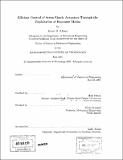| dc.contributor.advisor | Hani Sallun and David Trumper. | en_US |
| dc.contributor.author | Albert, Kevin B. (Kevin Bjorn) | en_US |
| dc.contributor.other | Massachusetts Institute of Technology. Dept. of Mechanical Engineering. | en_US |
| dc.date.accessioned | 2007-12-07T16:17:11Z | |
| dc.date.available | 2007-12-07T16:17:11Z | |
| dc.date.copyright | 2007 | en_US |
| dc.date.issued | 2007 | en_US |
| dc.identifier.uri | http://hdl.handle.net/1721.1/39743 | |
| dc.description | Thesis (S.M.)--Massachusetts Institute of Technology, Dept. of Mechanical Engineering, 2007. | en_US |
| dc.description | Includes bibliographical references (p. 115-117). | en_US |
| dc.description.abstract | This thesis explores the efficiency potential inherent to series elastic actuators during oscillatory tasks. Series elastic actuators have a spring intentionally placed at the actuator output that provides good force resolution and filters out high frequency disturbances from the environment. These properties are essential for robotic applications in which interactions with the environment are unknown, because they allow the actuators to maintain stable force control while protecting the drive train from harmful loadings. The spring can also be used to store energy similar to the way animals use their tendons during locomotory tasks. This thesis shows that by operating the actuators at the appropriate frequency, the storage of energy by the springs can be translated into large efficiency gains for the actuator. To show the efficiency gains of the actuator, a control scheme was developed that is capable of operating the actuators at and above their resonant frequency. The control scheme was based on spring force control allowing it to provide protection to the drive train while being robust to changes in link inertia due to manipulator configuration or environmental interactions. | en_US |
| dc.description.abstract | (cont.) The control scheme was designed to be sufficient for use in real world applications so as to provide experimental results that are representative of operation on a robot vehicle. The control scheme was implemented on a single-link benchtop test stand which was used to demonstrate the performance of the actuators. Experimental results are presented that demonstrate the conditions under which efficient actuation is possible. By comparing the experimental data to models of the hardware, the mechanisms through which power was lost were determined. The results indicate that at resonance there is the potential to achieve up to twice the efficiency obtained by a rigid actuator, however, in order to do so extra attention is needed in both hardware design and control. | en_US |
| dc.description.statementofresponsibility | by Kevin B. Albert. | en_US |
| dc.format.extent | 117 p. | en_US |
| dc.language.iso | eng | en_US |
| dc.publisher | Massachusetts Institute of Technology | en_US |
| dc.rights | M.I.T. theses are protected by copyright. They may be viewed from this source for any purpose, but reproduction or distribution in any format is prohibited without written permission. See provided URL for inquiries about permission. | en_US |
| dc.rights.uri | http://dspace.mit.edu/handle/1721.1/7582 | |
| dc.subject | Mechanical Engineering. | en_US |
| dc.title | Efficient control of series elastic actuators through the exploitation of resonant modes | en_US |
| dc.type | Thesis | en_US |
| dc.description.degree | S.M. | en_US |
| dc.contributor.department | Massachusetts Institute of Technology. Department of Mechanical Engineering | |
| dc.identifier.oclc | 181643644 | en_US |
